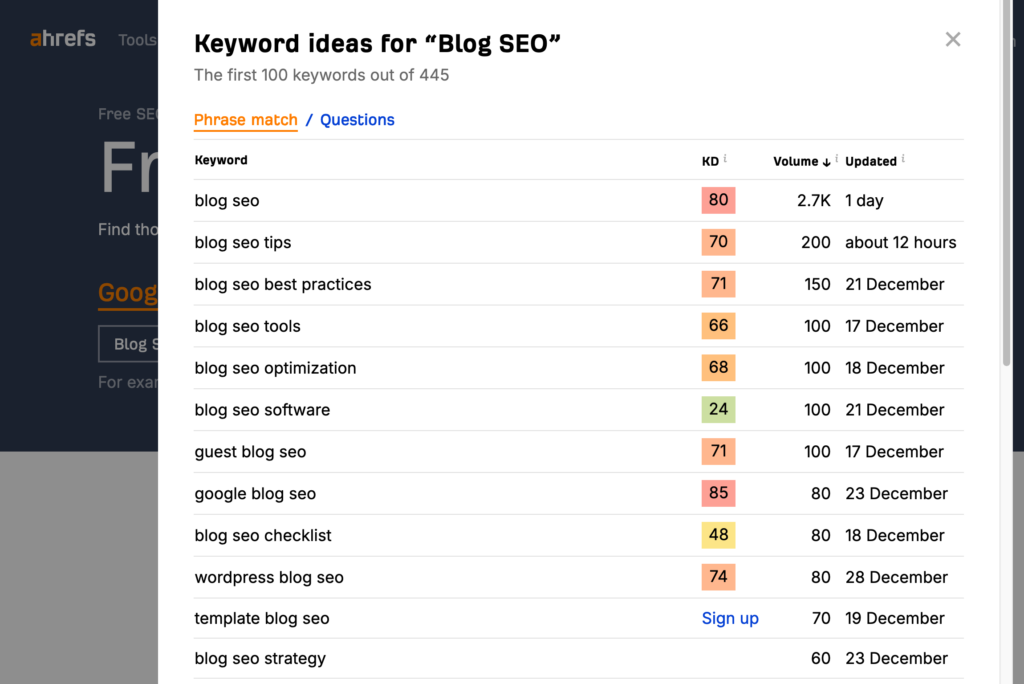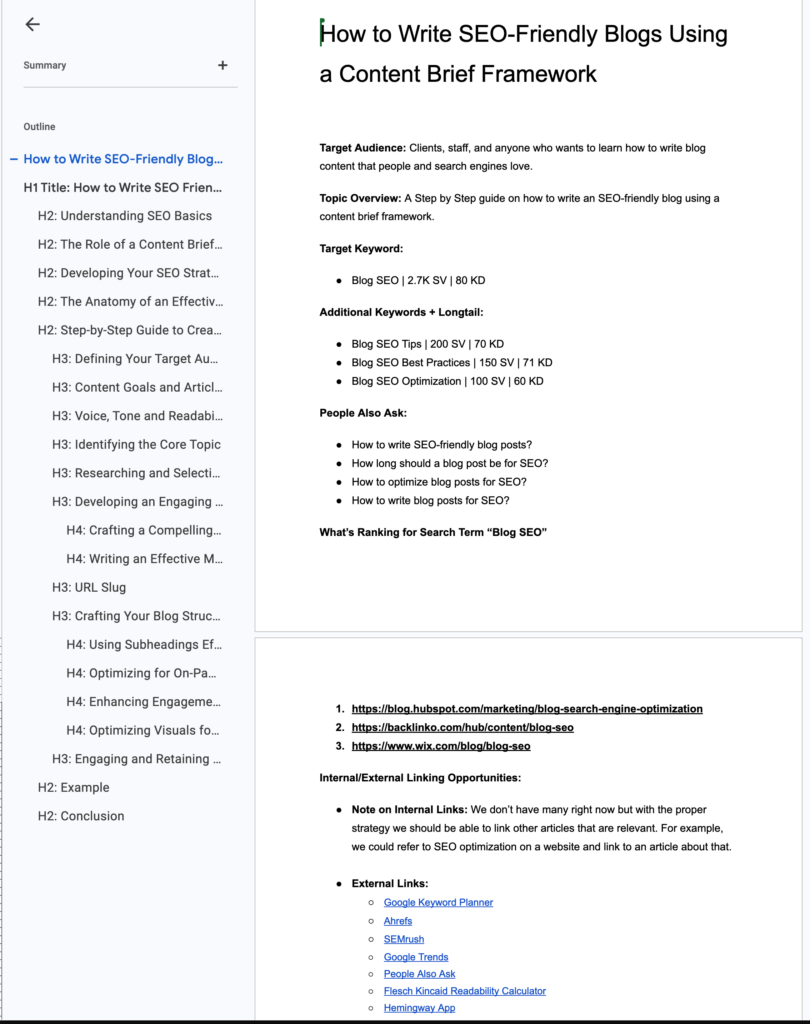How to Write SEO-Friendly Blogs Using a Content Brief Framework

SEO, or Search Engine Optimization, is a critical component of digital marketing. It involves optimizing your content so that it ranks higher on search engine results pages, making it more visible to your target audience. A content brief is a strategic blueprint for your blog posts, detailing the topic, target audience, keywords, and other elements crucial for SEO success. Let’s explore how to effectively combine SEO strategies with a well-structured content brief framework to create blogs that resonate with readers and search engines alike.
In today’s digital era, the art of blogging has evolved significantly, with Search Engine Optimization (SEO) emerging as a crucial element. Understanding and implementing SEO strategies can significantly enhance the visibility and reach of your blog content. This article delves into how to adeptly write a blog for SEO by utilizing a content brief framework.
Understanding SEO Basics
SEO involves optimizing your blog content to improve its visibility in search engine results. It’s vital because most internet users begin their online experience with a search engine. A well-optimized blog can attract more traffic, increase engagement, and enhance your online presence.
SEO encompasses various techniques and strategies aimed at improving the visibility and ranking of web content. Key aspects include keyword research, on-page optimization, and creating content that aligns with user intent. By mastering these basics, bloggers can significantly enhance their online presence and reach.
The Role of a Content Brief in SEO Strategy
A content brief serves as a roadmap for content creation, ensuring that every piece of content aligns with SEO goals and audience needs. It outlines the purpose, structure, and specific elements that should be included in a blog post, making it an indispensable tool for effective SEO blogging.
The framework is a strategic plan that outlines the specifics of what your blog post will cover. The goal is to ensure your content aligns with the best practices of SEO, while meeting the needs of your target audience.
Developing Your SEO Strategy
An effective SEO strategy begins with thorough research. Identifying the right keywords and understanding the topics your audience is interested in are crucial steps. Tools like Google Keyword Planner, Ahrefs, or SEMrush can provide insights into popular search terms and their competition levels.
Understanding your audience goes beyond knowing their demographics. It involves delving into their pain points, interests, and the type of content they find engaging. This knowledge enables you to tailor your content to meet their needs and preferences, increasing the likelihood of high engagement and sharing.
The Anatomy of an Effective Content Brief
An effective content brief includes several elements such as: topic overview, target audience, primary and secondary keywords, content goals, linking opportunities, meta description, desired tone and style, and specific SEO requirements. This comprehensive approach ensures that your content is well-structured and meets your SEO objectives.
A content brief framework includes the following:
Define the target Audience: Who will be reading this blog and why?
- Content Goals: What you aim to achieve with the blog post, such as educating the audience, solving a problem, or providing insights.
- Article Length: Target word count should be 1500 – 2000 words per blog
- Tone and Style: Identify the writing style and voice, to maintain consistency and keep the audience engaged.
- Topic Overview: A brief description of what the blog post will cover.
- Target Keywords: The primary and secondary keywords that the content should focus on. This should also include long tail keywords and search terms from places like Google Trends and People Also Ask. These resources show you what people are searching for and the exact words they use so you can incorporate them into your blog.
- Title and Meta Description: A catchy title and short description of the blog topics, using the target keywords.
- URL Slug: What will the blog page be named and how should it read in the web browser?
- Summary: A summary of the blog that goes into more detail about what the reader might glean from the subject.
- Structure: Outline sections with a clear hierarchy of information, with headers from H1 – H6.
- Internal Linking Opportunities: What other blogs, resources, FAQs, or web pages can you link to within the content for more context or to expound on an idea that was not the focus of the article.
- Product Linking: A call to action (CTA) link to sell a product or service.
Aligning your content with SEO goals means ensuring that these elements work in tandem to boost your blog’s visibility and relevance.
Step-by-Step Guide to Creating a Content Brief
Creating a content brief is a systematic process that involves several steps. Here’s how to go about it.
Defining Your Target Audience
Knowing your audience is the first step in creating a content brief. Understand as much as you can about their interests, pain points, and search behaviors to tailor your content accordingly. This ensures that your blog resonates with the readers and meets their needs.
Content Goals and Article Length
Your content goals should align with your overall marketing objectives. Whether it’s to increase brand awareness, generate leads, or educate your audience, clear goals help focus your content creation efforts and measure success.
Article length varies but the best practice is to shoot for 1500 – 2000 words per blog to ensure it has enough detail and value for the reader and the search engines.
Voice, Tone and Readability
Your introduction should be inviting and set the stage for what the reader can expect. Use a conversational tone, address the reader directly, and clearly state the purpose of your blog.
In order to clearly engage with your target audience you need to know how they like to be spoken to, and what reading level is most comfortable for them. The average American reads at the 5th – 7th grade reading level so it is encouraged to use plain language when possible and avoid jargon. Think about the difference between speaking to a child versus your boss. Very different voice and tone based on the target audience.
Tools like the Flesch Reading Ease Score and the Hemingway App can help you assess the readability of your content. They provide insights into sentence length, complexity, and overall readability.
Identifying the Core Topic
Start by identifying the main topic for your blog. It should be relevant to your audience and align with your SEO goals. Consider current trends, industry developments, and frequently asked questions by your audience.
Researching and Selecting Keywords

Conduct thorough keyword research to identify terms and phrases that your target audience is searching for. Use tools like Ahrefs, Google Keyword Planner or SEMrush to find relevant keywords with good search volume and low competition.
While it’s important to include keywords in your blog, they should fit naturally within the text. Avoid forced or awkward placements that can disrupt the flow and readability.
Developing an Engaging Title and Meta Description
Your blog’s title and meta description are critical for attracting readers and improving SEO. Let’s learn how to craft them effectively.
Crafting a Compelling SEO Title
The title should be catchy, include your primary keyword, and clearly convey the blog’s topic. It should also be concise and evoke curiosity or offer a solution to a problem.
Writing an Effective Meta Description
The meta description provides a brief summary of your blog’s content. Include your primary keyword and make it engaging and informative to encourage clicks from search engine results pages.
URL Slug

A URL (Uniform Resource Locator) Slug is the last part of the website address that leads you to a specific page. For example www.blogsite.com/this-part-is-the-url-slug. It is usually based on the title of the page and is keyword rich to give further relevance to make it more user friendly to visitors and search bots as they crawl and index your site to provide a relevant answer to a search.
Most websites have blog software like WordPress that allows you to choose what the URL will look like in the web browser. It is important to incorporate the target keywords for your target audience.
Crafting Your Blog Structure
Sections written with a clear hierarchy of information, outlined with headers from H1 – H6. This helps the reader and the search engine understand the relevance and context and shows that it’s of higher value to push it up in search results.
The structure of your blog plays a significant role in both SEO and user experience. A structured approach to content creation helps maintain focus and consistency. It ensures that all critical SEO elements are considered and integrated seamlessly into your blog post.
The main body of your blog is where you delve into the details of your topic. The use of bullet points, lists, and short paragraphs enhances readability and keeps your audience engaged. Here’s how to optimize it for SEO and reader engagement.
Writing for SEO involves a delicate balance between using keywords naturally and maintaining the quality of your content. Keyword stuffing, the practice of overusing keywords, can lead to a negative user experience and potentially harm your SEO efforts. Instead, focus on integrating keywords seamlessly into your content in a way that feels natural and adds value.
Creating informative and high-quality content is paramount. Your blog posts should provide answers, solve problems, or offer insights that are relevant to your audience. This not only helps in retaining readers but also positions you as an authority in your niche.
Using Subheadings Effectively
Subheadings break up the text and make it more readable. They also provide opportunities to include secondary keywords and improve the SEO of your blog.
Optimizing for On-Page SEO
On-page SEO is the practice of optimizing individual web pages to rank higher and earn more relevant traffic in search engines. Key elements include:
- Internal Linking: Linking to other relevant content on your site helps keep readers engaged and improves site navigation.
- External Linking: Linking to credible external sources can add value to your content and improve its trustworthiness.
Enhancing Engagement with Images and Videos
Images and videos make your blog more engaging and can help explain complex concepts. Ensure they are relevant, high-quality, and properly optimized with alt tags containing keywords.
Optimizing Visuals for SEO
When using visuals, remember to optimize them for SEO. This includes compressing file sizes for faster loading and using descriptive file names and alt tags that include your keywords. Make sure to optimize meta tags and image alt text. These help search engines understand the content of your page and its relevance to specific search queries.
Engaging and Retaining Your Audience
Engaging your audience is crucial for the success of your blog. Encourage interaction by inviting comments, feedback, or questions at the end of your post. Additionally, strategies like incorporating call-to-actions (CTAs) or offering downloadable resources can increase the time readers spend on your page.
Example

Download the PDF of this blog to illustrate the content brief in action. This content brief produced the blog you just read. Using this example and the step-by-step instructions above you should be able to write SEO friendly blogs for yourself, your business, and your clients.
Conclusion
When you utilize this framework you will see a marked improvement in your engagement, and organic traffic compared to writing articles without it. SEO (Search Engine Optimization) has become a cornerstone in the realm of digital content creation. The ability to craft blog posts that not only captivate readers but also rank well in search engine results is a skill highly sought after in the blogging community. A crucial element in achieving this is the use of a content brief framework. A well-structured content brief serves as a roadmap, guiding writers in creating SEO-friendly content that resonates with their target audience.
